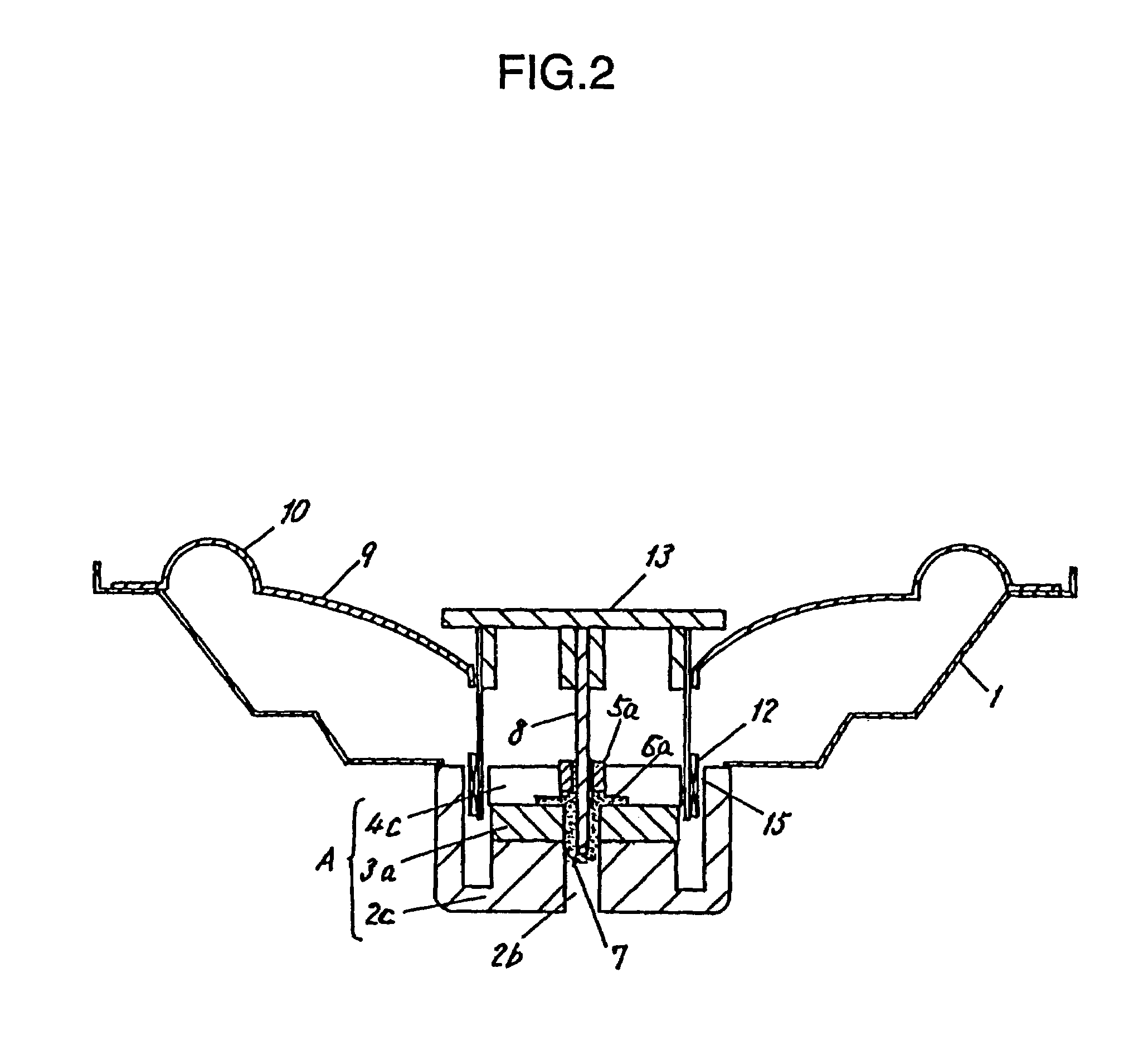Speaker
a loudspeaker and speaker technology, applied in the field of loudspeakers, can solve the problems of deteriorating sound, unable to completely prevent the generation of abnormal sounds, and abnormal noise, so as to improve symmetrical vibration, reduce frictional resistance with the shaft, and improve flexibility.
- Summary
- Abstract
- Description
- Claims
- Application Information
AI Technical Summary
Benefits of technology
Problems solved by technology
Method used
Image
Examples
first embodiment
[0025]A speaker in accordance with an exemplary embodiment of the present invention is described referring to FIG. 1 and FIG. 2.
[0026]In a speaker of the present invention, an inner magnet type magnetic circuit A is formed of a yoke 2a, a magnet 3a and a top plate 4a, and the magnetic circuit is provided with a through hole 2b at the center, as shown in FIG. 1. A frame 1 is fixed on the yoke 2a of magnetic circuit A. A diaphragm 9 and an edge 10 are fixed on the frame 1. A bobbin 17 of a voice coil 12 is fixed to an inner circumference of the diaphragm 9, and the voice coil 12 is supported in a magnetic gap 15 formed by the yoke 2a and the top plate 4a. A center cap 13 is fixed on the bobbin 17 at the top edge, so as to be coaxial with the axis of the bobbin 17.
[0027]A bearing 5 is fixed to be coaxial with the axis of the through hole 2b. A shaft 8 is fixed at the top end to a center of the center cap 13, and supported by the bearing 5 so that it can move up and down.
[0028]The yoke ...
second embodiment
[0034]A speaker in accordance with a second exemplary embodiment of the present invention is described referring to FIG. 3 and FIG. 4. Description is made focusing on a point of difference from the first embodiment.
[0035]FIG. 3 is a cross-sectional view of a speaker in the present embodiment, while FIG. 4 is a characteristics chart showing a relation between maximum amplitudes and frequency characteristics. As FIG. 3 shows, the speaker of the present embodiment is provided with a damper 11, which is fixed at the outer circumference to the frame 1 and at the inner circumference to the voice coil 12. In the speaker of the first embodiment, where a damper is eliminated, the vibration system is provided with full flexibility; however, the up and down motion is not controlled until the edge 10 is expanded to its full length. So, a leap phenomenon or a distortion due to asymmetry among the up-side and down-side amplitudes can readily occur. The configuration in the present embodiment addr...
third embodiment
[0038]FIG. 5 is a cross-sectional view of a speaker in accordance with a third exemplary embodiment of the present invention. FIG. 6 shows a cross-sectional view of the key part, or a bearing. In the following, the differences from the first and the second embodiments are described.
[0039]As shown in FIG. 5, the difference from the first embodiment is that a speaker in the present embodiment 3 is provided with a bearing cover 16 surrounding the bearing 5, which is disposed on the upper surface of the top plate 4a in a location around the through hole 12b. In case magnetic fluid 7 is pushed out from the top end of bearing 5, it might be pulled into the magnetic gap 15 if the bearing cover 16 is not provided. If the magnetic fluid 7 is pulled into the magnetic gap 15 in volume, it would clog the magnetic gap 15 to generate abnormal sound. Or, the gap between bearing 5 and shaft 8 might be short of magnetic fluid 7, which also would cause abnormal sound. The present embodiment addresses...
PUM
 Login to View More
Login to View More Abstract
Description
Claims
Application Information
 Login to View More
Login to View More - R&D
- Intellectual Property
- Life Sciences
- Materials
- Tech Scout
- Unparalleled Data Quality
- Higher Quality Content
- 60% Fewer Hallucinations
Browse by: Latest US Patents, China's latest patents, Technical Efficacy Thesaurus, Application Domain, Technology Topic, Popular Technical Reports.
© 2025 PatSnap. All rights reserved.Legal|Privacy policy|Modern Slavery Act Transparency Statement|Sitemap|About US| Contact US: help@patsnap.com



